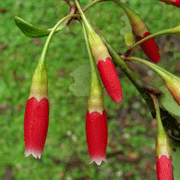James L. Luteyn and Paola Pedraza-Peñalosa
The New York Botanical Garden
|
|
Polyclita is a monotypic genus endemic to northern Bolivia. According to Smith (1936), it is related to Thibaudia and distinguished by the calyx, which is continuous with the pedicel and angled or winged opposite the lobes (with which it has in common with Mycerinus). In the few Thibaudia species with continuous calyces, the angles or wings are alternate with the lobes. Kuntze (1891) originally suggested a relationship to Psammisia, when he suggested Psammisia as a subgenus (or section) of Chupalon. I feel that it is related to the Macleania-Psammisia-Mycerinus group of genera and could in fact be a Psammisia, especially in view of the fact that rarely spurs occur on the stamen, which do fit in with Psammisia stamen. |
POLYCLITA A. C. Smith, Bull. Torrey Bot. Cl. 63: 314.
1936. Type: Polyclita turbinata (O. Ktze.) A. C. Smith. Monotypic. The following is a combined generic and specific description.
Polyclita turbinata A. C. Smith, Bull. Torrey Bot. Cl. 63: 314. 1936. Chupalon turbinatum O. Ktze., Rev. gen. pl. 3(2): 190. 1898. Thibaudia turbinata (O. Ktze.) Hoer., Bot. Jahrb. Syst. 42: 272. 1909. Type. Bolivia. Santa Rosa, 2000-2600 m, 3 Apr 1892 (fl), Kuntze s.n. (holotype B†; lectotype, not yet designated, NY).
Terrestrial or epiphytic shrub, branchlets subterete, glabrous, cinereous; bud scales not stipular. Leaves alternate, coriaceous, evergreen, ovate to slightly obovate, 5-8 x 3-5 cm, subattenuate at base, rounded at apex, glabrous, margins entire; pinnately nerved, midrib impressed above and prominent beneath, lateral nerves 3-5 per side, spreading or ascending, plane above and raised beneath, reticulate veinlets plane or slightly raised on both surfaces; petiole subrugose, glabrous, narrowly winged, 4-5 mm long. Inflorescence axillary, short-racemose, with 2-6 pedicellate flowers, glabrous in all parts; rachis less than 5 mm long; floral bract inconspicuous, oblong, acute, 2 mm long; pedicel rugose, 15-20 mm long; bracteoles 2, basal. Flowers with calyx continuous with pedicel; hypanthium obconic, long-attenuate at base, 4-6 mm long, 5-angled or narrowly winged opposite the lobes; limb erect; lobes apiculate, thin-margined, 1-1.5 mm long; sinuses rounded; corolla cylindric, thick-carnose, bistratose, 15-16 mm long and ca. 4 mm diam., the lobes 1.5 mm long; stamens 10, equal, nearly equalling corolla, ca. 16 mm long; filaments distinct, ca. 3 mm long, much shorter than anthers, pilose distally; connective (or base of tubule) sometimes slightly spurred, sometimes spurs only on alternate stamens, or sometimes spurs none; anthers lacking disintegration tissue; thecae slightly granular, rigid, 9-10 mm long, incurved at base; tubules slightly shorter than thecae, broad, flexible, 5-6 mm long, dehiscing by elongate oval clefts half to nearly the entire length of the tubule; pollen without viscin threads; ovary inferior; style thick, subequalling corolla or exserted; nectariferous disc not seen. Fruit a spherical berry.
Key to Neotropical Species Back to Top
A complete treatment is lacking, and this synthesis comes from Luteyn's unpublished notes.
